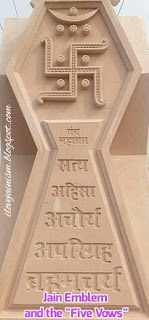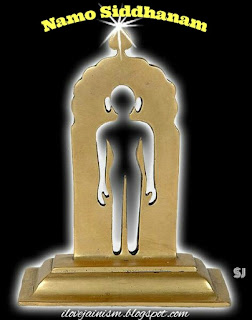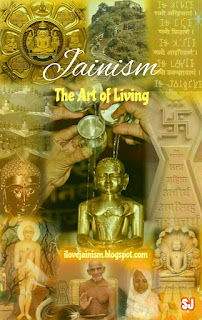"Jainism"
"The Art of Living"
Jainism is a living faith, a dynamic religion which exemplifies the highest and noblest values, moral upliftment and spiritual elevation, leading to eternal peace and infinite bliss. Jainism is a significant and prominent religion of India.
Jainism, one of the three major religions of early India, has been continuously practised since around the middle of the first millennium BC. Its name derives from the Sanskrit word Jina, meaning 'liberator' or 'victor'. One who has conquered all inner passions like attachment, desire, anger, pride, greed, etc. is called Jina. Followers of the path practiced and preached by the jinas are known as "Jains".
 |
| Jain Emblem and the "Five Vows" |
"Parasparopagraho Jivanam" (the function of souls is to help one another) is the motto of Jainism.
Jain Dharma is an ancient Indian religion belonging to the śramaṇa tradition, the religion of Nirgantha, or the religion of Jin. The central tenet is non-violence and respect towards all living beings. The three main principles of Jainism are ahimsa (non-violence), anekantavada (non-absolutism) and aparigraha (non-possessiveness).
Ahimsa (Non-violence): The principle of Ahimsa is the backbone and focal point of Jainism, which aims at the welfare of all living beings, not only humans. Thus, Jainism is a religion of compassion, universal love and amity.
Anekantvada (Non-absolutism): Anekantvada teaches the realisation of truth in its varied aspects, inducing one to respect and accept a wide range of viewpoints in a spirit of cooperation. The principle of non-absolutism is, thus, a valuable contribution of Jainism to the world of philosophy.
Aparigraha (Non-possessiveness): The attitude of Aparigraha begets equanimity, whereas attachment to worldly objects results in bondage. Therefore, one desirous of spiritual liberation should withdraw from all attachments to material things and practise non-possessiveness.
If one observes these three tenets in their true spirit, peace and harmony can be attained not only within, but also without – in the world.
Followers of Jainism take five main vows: ahimsa (non-violence), satya (not lying), asteya (not stealing), brahmacharya (chastity) and aparigraha (non-attachment).
FIVE GREAT VOWS:
Ahimsa (Non-violence): To abstain from causing harm to any living being.
Satya (Truthfulness): To speak only the innocuous truth.
Achaurya (Non-stealing): To refrain from taking anything without the permission of its owner.
Brahmacharya (Celibacy): Abstinence from sexual indulgence.
Aparigraha (Non-possessiveness): To abstain from having possessions and possessiveness towards anything.
These five vows must be strictly observed by Jain monks and nuns in their entirety. However, partial observance of these vows has also been formally laid down for householders, with seven additional vows. These enable the gradual and smooth progress of the soul on the path of liberation leading to moksh.
"Samyakdarshangyancharitrani Mokshmargasya" is the fundamental principal of Jainism:
The ultimate goal of Jainism is for the soul to achieve liberation .This goal can be attained by adopting the right path of moksh (liberation), connoted by the cultivation, development and unification of the three spiritual jewels, namely:
Samyak Darshan (Right Faith): It is the faith in the true nature of the substances as they are. Having right belief of God, Guru and Religion is samyak darshan.
Samyak Jnan (Right Knowledge): It is that knowledge which reveals the nature of things neither insufficiently, nor with exaggeration, nor falsely; but exactly as they are and with certainty.
Samyak Charitra (Right Conduct): It is to free oneself from raag (attachment), and dwesh (aversion), from all the impure activities of thoughts, words and deeds and attain vitragta (the state of perfect equanimity).
As defined in "Tattvartha Sutra"...
"Samyakdarshangyancharitrani Mokshmargasya".
It means: "True Perception, True/Right Knowledge and True/Right Conduct" is the path to attain Moksha.
Moksha is attained by getting liberated from all Karma. Those who have attained Moksha are called "Sidhdhatma"(Omniscient Soul) and those who are attached to the world & other souls through Karma are called Sansari (living beings). Every soul has to follow the path of Moksha as described.
God
God in Jainism:
 |
| Four and Twenty Tirthankaras |
Jain texts reject the idea of a creator or destroyer God and postulate an eternal universe. Jain cosmology divides the worldly cycle of time into two parts (avasarpiṇī and utsarpiṇī). According to Jain belief, in every half-cycle of time, twenty-four Tīrthaṅkaras grace this part of the Universe to teach the unchanging doctrine of right faith, right knowledge and right conduct. The word "Tīrthankara" signifies the founder of a tirtha, which means a fordable passage across a sea. The Tīrthaṅkaras show the 'fordable path' across the sea of interminable births and deaths. Rishabhanatha is said to be the first Tīrthankara of the present half-cycle (avasarpiṇī). Mahāvīra (6th century BC) is revered as the last tīrthankara of avasarpiṇī.Though Jain texts explain that Jainism has always existed and will always exist,modern historians place the earliest evidence of Jainism in the 9th century BC.
 |
| Infinite Liberated souls (Siddhas) |
In Jainism, perfect souls with the body are called Arihant ("victors") and perfect souls without the body are called Siddhas ("liberated souls"). Tirthankara is an arihant who helps others to achieve liberation. Tirthankaras become role models for those seeking liberation. They are also called human spiritual guides.They reorganise the four-fold order that consists of muni ("male ascetics'), aryika ("female ascetics"), śrāvaka ("laymen"), and śrāvikā ("laywoman").Jainism has been described as a transtheistic religion, as it does not teach dependency on any supreme being for enlightenment. The tirthankara is a guide and teacher who points the way to enlightenment, but the struggle for enlightenment is one's own.
Jain Prayer:
 |
| Namokar Mantra - Navkar Mantra |
The sacred prayer is the Namaskär, Navkär or Namokär Mahämantra in which homage is paid to the five worshipful personalities (Panch Parameshthi): Arihanta (enlightened human beings), Siddha (liberated souls), Ächarya (head of Jain congregation), Upädhyäya (ascetic teachers), and all Sädhu (all ascetics).
Namokär Mantra:
Namo Arihantänam
Namo Siddhänam
Namo Äyariyänam
Namo Uvajjhäyänam
Namo Loe Savva Sähunam
Eso Panch Namukkäro
Savva Päva Panäsano
Mangalänam cha Savvesim
Padhamam Havai Mangalam.
The "Navkar Mantra" is the fundamental prayer of Jainism and may be recited at any time. In this mantra, Jains worship the gunas ("qualities") of the spiritually supreme, including those who have already attained salvation, in order to adopt similar behavior.
Jain Festivals:
Major Jain festivals include Paryushana and Daslakshana, Mahavir Jayanti, and Diwali.
The Jains observe two principal festivals in their religious calendar. The first is Diwali, the festival of lights, which marks the release (moksha) from the cycle of rebirth of Mahavira, the most recent Jina. The lighting of candles is intended to dispel the darkness created by his departure. The second is Paryushan, It is the festival of forgiveness, when Jains retire to repent, fast and meditate.
Pilgrimages:
 |
| Jal Mandir at Shikharji, said to be the place where 20 tirthankars achieved Nirvana |
Jain pilgrim (Tirtha) sites are divided in the following categories:
Siddhakshetra – Site of the moksha of an arihant (kevalin) or Tirthankara, such as Ashtapada, Shikharji, Girnar, Pawapuri, Palitana, Mangi-Tungi and Champapuri (capital of Anga).
Atishayakshetra – Locations where divine events have occurred, such as Mahavirji, Rishabhdeo, Kundalpur, Tijara Jain Temple, Aharji.
Puranakshetra – Places associated with lives of great men, such as Ayodhya, Vidisha, Hastinapur, and Rajgir.
Gyanakshetra – Places associated with famous acharyas, or centers of learning, such as Shravanabelagola.
Monasticism :
 |
Acharya Bahubali , a prominent Digambara
Acharya (the head of a monastic order)
|
In Jainism, monasticism is encouraged and respected. Monks and nuns live extremely austere and ascetic lifestyles. They follow the five main vows strictly and observe complete abstinence. Jain monks and nuns have neither a permanent home nor any possessions. They do not use vehicles and always travel barefoot from one place to another, irrespective of the distance. They wander from place to place except during the months of Chaturmas. They do not prepare food and live only on what people offer them. Digambara monks and nuns carry a broom-like object, called a picchi (made from fallen peacock feathers) to sweep the ground ahead of them or before sitting down to avoid inadvertently crushing small insects.Svetambara monks carry a rajoharan (a broom-like object made from dense, thick thread strands). Jain monks have to follow six duties known as avashyakas: sāmāyika (practising serenity), chaturvimshati (praising the tirthankara), vandan (respecting teachers and monks), pratikramana (introspection), kayotsarga (stillness), and pratyakhyana (renunciation).
Universal Forgiveness and Friendship Sutras:
Jains recite the following Sutras for confession of their sins, requesting forgiveness from others, and desiring peace over entire universe to all living beings.
Khämemi Savve Jive Sutra:
Khämemi Savve Jive, Savve Jivä Khamantu Me,
Mitti Me Savve Bhuyesu, Veram Majham Na Kenai.
I ask forgiveness of all living beings,
May all living beings grant me forgiveness.
My friendship is with all living beings,
I have no enmity with anyone.
RELEVANCE IN MODERN TIMES:
In this day and age, where suspicion and distrust are vitiating the atmosphere of international peace and brotherhood, where the world is filled with fear and hatred, the tenets of Jainism are like the oasis in the desert, an answer to a desperate need. It is a perfect blend of philosophy and practicality, an ethical system par excellence. Not stopping at mere philosophy, Jainism is a way of life,
an Art of Living, proficient enough to elevate an ordinary individual to the greatest height of spiritual realisation. It is imperative that we embrace this philosophy which bears the message of love and respect, non-violence and peace – both internal and external, personal and universal.

